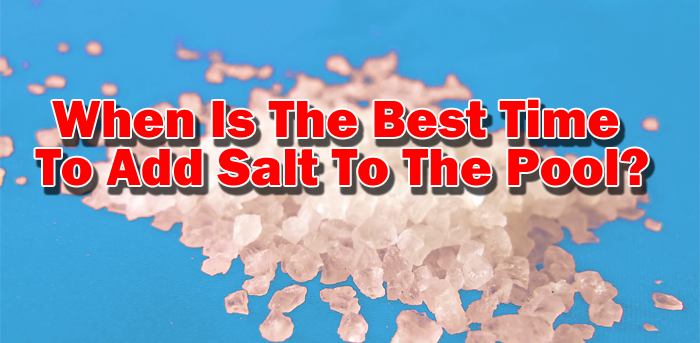Being in the business of salt pools, naturally one of our most frequently asked questions is “How do we add the salt?” Almost as often we hear “When do I need to add more?”
These questions are typical of the new salt pool owner, so let’s briefly look at the “how”, “where”, and “when” of managing salt additions.
How? The how and the where of the question very often intersect. The critical points are to distribute the salt around the pool a bit, and to ensure that the circulation system is running. As salt dissolves it temporarily forms a solution heavier than water that, if left in place too long, can damage the plaster or lining of a pool. Therefore the best practice is to brush the salt so that it does not sit in piles on the pool bottom as it dissolves. Other methods of distribution and circulation can be employed, if they suit the pool. One client of ours pours the salt, a bag at a time, into the running water of their slide, which then speeds the dissolving process, disperses the salt over the deep end, and aids in mixing the solution into the pool. Another time saving option may be to run the pool vacuum, having first disconnected or shut down the removal function.
It should be noted that some chlorine generators must be turned off during the water salting process. Be sure to consult your owner’s manual.
Where? Generally, you should always add salt to the deepest end of the pool. The additional water there offers the walls the most buffer from the dissolving salt, as well as often offers proximity to a main drain. If you intend to add a large quantity at once, start by placing each bag of salt side by side around the perimeter of the deep end. You can then slice the underside of the front of each bag, allowing the salt to spill in unassisted until just a bit is left, saving both time and your back in the process.
Sometimes clients find that adding salt to the pool directly is not always their best option. In the case of gutter pools, salt can often be added successfully to the surge pit.
When? I believe it should go without saying that salt should be treated like any other pool chemical and should be added when the pool is closed and does not contain bathers. Beyond that, the question is more about when do you add additional salt to maintain desired salinity, once the initial salting has been accomplished. Far too often we receive tech support calls, asking to troubleshoot a generator that isn’t producing enough or at all, only to find that the salinity level of the pool has dropped too low for the generators to function properly. The operator then adds a large amount of salt to the pool and the generator resumes operation. This drastic swing not only results in wasted man hours and frustration, but also causes undue stress on the chlorine generator, potentially shortening the lifespan of the cell.
The best way to avoid having this occur is to make salinity measurement and salt addition a part of the scheduled routine. Many quality digital meters are available on the market, and we highly recommend them over salinity test strips, but whatever your testing method, make testing your salinity a weekly process (at a minimum). If you are not already balancing your pool to LSI each week, include that on the day you measure your salinity. Record each measurement and have a salinity cut off point. That is to say, if your system runs optimally at 4500ppm, consider making 4000ppm the level your water must reach before you add salt. Then, calculate out exactly how many lbs. of salt are required to bring your pool from 4000ppm to 4500ppm, and have it posted clearly for any and all staff that would be making the addition. Once the measured salinity of the pool water reaches 4000ppm, you or your staff adds the required amount of salt, and your routine continues on smoothly. No need to calculate out each time how much salt to add, no risk of damaging your equipment by operating at too low a salinity. Simple.
So, there you have the answers to a few of our most frequently asked questions. Do you have any tips or suggestions to contribute? We’d love to hear what you have to say.


